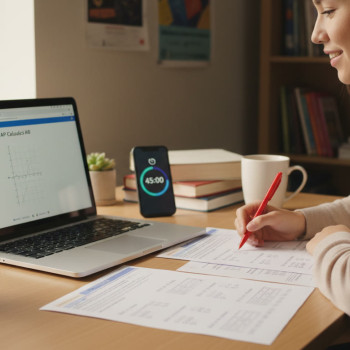Why Source Credibility Matters: From TOK to AP Seminar
When you’re preparing for TOK (Theory of Knowledge) or AP Seminar, you’re not just collecting facts. You’re building arguments, weighing perspectives, and persuading readers — often under the watchful eye of examiners who prize credible reasoning as much as impressive conclusions. A well-chosen source can lift an entire project; a careless source can sink it. This blog gives you clear, practical checklists and examples you can use right away to assess the credibility of anything you read online, in journals, or in libraries.

The thread that connects TOK and AP Seminar
TOK asks you to reflect on how knowledge is produced and justified. AP Seminar asks you to apply similar thinking in a research-and-argument context: identify a problem, collect evidence, assess multiple perspectives, and craft a team- or individual-based presentation or paper. Both demand careful source evaluation, but AP Seminar also expects you to document that evaluation and use it to justify methodological choices.
Quick Credibility Checklist: The Five-Minute Triage
Sometimes you need to decide fast whether a source is worth deeper attention. Use this five-minute triage before you invest time reading or citing something.
- Who produced it? — Author or organization named? Credentials visible?
- When was it published? — Date matters, especially in fast-moving fields.
- Where is it published? — Peer-reviewed journal, reputable news outlet, institutional white paper, or an anonymous blog?
- Why was it produced? — Inform, persuade, sell, entertain?
- How is it supported? — Data, references, transparent methods, or just confident assertion?
If a source passes this triage, you move to a deeper evaluation. If it fails, set it aside unless you need it as an example of biased or unreliable information — which can be useful in TOK.
Deep-Dive Checklist: A Systematic Source Evaluation
Use this checklist when a source will be cited in your AP Seminar paper or TOK presentation. Print it, save it as a template, or convert it into a one-page form for later reflection.
- Authority
- Who is the author? Look for academic degrees, institutional affiliations, and previous publications.
- Is the author recognized by peers? Citations, awards, or mentions in other credible outlets are good signs.
- Accuracy
- Does the source cite primary data or reputable studies? Check footnotes and references.
- Are claims consistent with other trusted sources?
- Purpose and Bias
- Why was this written? To inform, influence policy, sell a product, or promote an ideology?
- Identify potential conflicts of interest — funding sources, affiliations, or sponsorships.
- Currency
- Is the information current enough for your topic? Historical topics may be fine with older sources; technical topics usually need recent research.
- Methodology
- For studies: Were methods described clearly? Is the sample size adequate? Are limitations acknowledged?
- Corroboration
- Do other independent sources support this claim? If not, why might that be?
- Presentation
- Is the writing professional? Are there glaring errors, emotive language, or manipulative visuals?
Tip: Turn Checklists into a Habit
Attach a 2–3 sentence sentence rationale to each source in your notes explaining why you trust it and where it fits your argument. This helps when you write your literature review, annotate sources, or prepare evidence logs for AP Seminar’s performance tasks.
Practical Examples: Applying the Checklist
Concrete examples help the checklist become intuitive. Below are two scenarios — one where a source proves robust, and another where caution is necessary.
Example 1 — Scholarly Article
Source: A peer-reviewed study published in a recognized journal, authored by researchers affiliated with universities. The paper includes methods, data, and a limitations section.
- Authority: High — authors with relevant credentials.
- Accuracy: High — cites prior work and raw data is available.
- Bias: Low — funded by a public grant, with conflicts disclosed.
- Currency: Depends — if the topic is medicine, recent; if it’s a 19th-century literary analysis, older is fine.
Verdict: Strongly usable. Quote carefully, and note limitations in your paper.
Example 2 — Opinion Piece on a News Site
Source: An op-ed by a think-tank fellow arguing for a policy change.
- Authority: Medium — author is an expert but affiliated with an advocacy group.
- Accuracy: Variable — uses statistics but with selective framing.
- Bias: Noticeable — purpose is persuasion.
- Currency: Likely current.
Verdict: Useful for illustrating a viewpoint, but balance it with neutral or opposing sources. Use it to analyze rhetoric in TOK or to show perspective variety in AP Seminar.
Checklist Quick-Reference Table
| Criterion | What to Look For | Score (1–5) |
|---|---|---|
| Authority | Author credentials and institution | ___ |
| Accuracy | References, data availability, peer review | ___ |
| Bias / Purpose | Funding, affiliation, persuasive intent | ___ |
| Currency | Publication date appropriate to topic | ___ |
| Methodology | Clear methods, sample size, limitations | ___ |
| Corroboration | Independent confirmation from other sources | ___ |
Use this table to score each source. A combined score helps you prioritize the strongest evidence when you write.
Special Considerations for TOK
TOK isn’t just about whether a source is factually accurate; it’s about understanding how knowledge is constructed and the limits of different ways of knowing.
- Perspective and Context: Who is producing knowledge and how does their cultural, ethical, or historical position influence what is presented?
- Ways of Knowing: Consider perception, reason, emotion, language — each plays a role in how a source frames information.
- Knowledge Claims vs. Knowledge Questions: Use sources as evidence for knowledge claims, then interrogate them with knowledge questions.
In TOK, a seemingly biased source can be incredibly valuable because it exposes how values and assumptions shape knowledge — which is a perfectly defendable stance in your oral or essay work.
Applying the Checklists in AP Seminar
AP Seminar asks for documented research and purposeful synthesis. Here’s how to integrate your credibility checks into the AP process.
- Maintain an Evidence Log: For each claim, list the source, your short credibility score, and a sentence about how it supports your claim.
- Balance Perspectives: Include sources representing at least two credible opposing views; examine their assumptions and methods.
- Annotate Methodology: When you use empirical studies, explain why their methods are appropriate or why you adjusted their conclusions in light of limitations.
How this lifts your AP Seminar score
Examiners look for: clear argument, appropriate use of evidence, critical evaluation, and synthesis. Your credibility checklists are the scaffolding that proves you thought deeply about your sources — not just that you found them.
Common Pitfalls and How to Avoid Them
Students often make predictable errors when evaluating sources. Spotting and avoiding these can save time and strengthen your work.
- Relying only on surface signals: A professional layout doesn’t guarantee accuracy. Always check authorship and references.
- Cherry-picking supportive data: Don’t ignore contradictory evidence; acknowledge it and explain why you still find your conclusion reasonable.
- Overvaluing recency: Newer isn’t always better. Interpret dates in context — classic theory remains valuable even if old.
- Assuming peer review means infallibility: Peer review reduces error but doesn’t eliminate debate or bias. Read critically.
Practical Workflow: From Finding Sources to Final Draft
Here’s a reproducible workflow that turns a pile of links into a coherent, credible argument.
- Define your research question clearly — narrow it to something answerable within the AP Seminar scope.
- Do a broad search and collect 15–25 candidate sources (mix of primary, secondary, and credible media).
- Apply the five-minute triage to discard obviously irrelevant or unreliable items.
- Deep-evaluate the remaining 10–15 sources using the systematic checklist and score them in the table.
- Create an evidence log with quotes, paraphrases, page numbers, credibility notes, and how you intend to use each source.
- Outline your argument, integrating sources where they support or complicate your claims. Be explicit about trade-offs and limitations.
- Write drafts, citing sources and explaining methodology choices. Use TOK-style reflection where appropriate to discuss knowledge construction.
- Revise with feedback from peers, teachers, or a tutor, and finalize your bibliography and annotated notes.
Where personalized tutoring helps — Sparkl’s example
Working with a tutor can speed up this process. Sparkl’s personalized tutoring model, for instance, offers 1-on-1 guidance to refine research questions, tailor study plans, and interpret methodology. An expert tutor can review your evidence log and help you strengthen synthesis and argumentation — especially valuable in the final revision stages.
Evaluation Templates You Can Use (Copy-Paste Ready)
Save time with simple templates that make credible practices routine. Below are two short templates — one for quick triage, one for in-depth evaluation.
-
Five-Minute Triage Template:
- Title: __________
- Author/Org: __________
- Date: __________
- Publisher Type (journal/news/blog): __________
- Quick Verdict: Use / Use with Caution / Discard
-
Deep-Evaluation Template:
- Authority Score (1–5): ___
- Accuracy Score (1–5): ___
- Bias Score (1–5): ___
- Currency Score (1–5): ___
- Methodology Score (1–5): ___
- Corroboration Score (1–5): ___
- Net Assessment (Strong / Moderate / Weak): ____
- How I’ll use it in my paper: __________________________
Example Annotation — A Model You Can Copy
When you annotate a source, be concise but precise. Here’s a model annotation you can adapt for your evidence log.
Smith, J. (2019). “Urban Heat Islands and Policy Responses.” Journal of Environmental Planning. — Authority: University-affiliated climatologist; peer-reviewed. Methods: City temperature data 2000–2017, regression analysis with socioeconomic controls. Limitations: Limited geographic scope (three cities). Use: Supports claim that policy interventions reduce heat disparity; note limitation when generalizing nationwide.
Putting It Together: From Credibility to Clear Argument
Strong papers and TOK presentations show that you don’t just gather sources — you interrogate them. Explain why you trust certain evidence, how it interacts with other evidence, and what assumptions underlie each claim. That explicit reflection demonstrates intellectual maturity and will impress AP Seminar readers and TOK examiners alike.

Final Checklist Before Submission
- Do all cited sources have basic credibility notes in your evidence log?
- Have you included at least two contrasting perspectives and explained their differences?
- Did you acknowledge limitations and gaps in the evidence?
- Is your bibliography consistent and correctly formatted?
- Have you practiced explaining your source choices aloud (useful for oral defense or presentation)?
Closing Thoughts: Credibility as Skill, Not Just a Requirement
Evaluating sources is a transferable skill — one that will serve you well beyond AP Seminar or TOK. Whether you’re reading news, deciding whom to trust in debates, or preparing college applications, a clear habit of source evaluation helps you think more clearly and argue more persuasively. Start small, use the checklists, annotate consistently, and ask for feedback. If you want targeted help, a personalized tutor can accelerate that learning curve: Sparkl’s tutors, for example, focus on tailoring feedback, designing a study plan that fits your timeline, and offering AI-driven insights to spot gaps you might miss.
One Last Tip
When in doubt, treat a source as material for critique rather than unquestioned truth. That mindset opens opportunities: in TOK, it becomes a lens for ethical and epistemic reflection; in AP Seminar, it becomes a way to show sophisticated reasoning. Good luck — and remember: strong evidence, clearly evaluated, is the backbone of every excellent argument.

















No Comments
Leave a comment Cancel